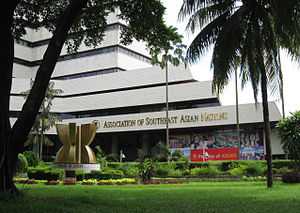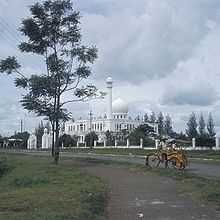Kebayoran Baru, South Jakarta

Kebayoran Baru is a subdistrict of South Jakarta, Jakarta, Indonesia. Kebayoran Baru was the last residential area to be developed by the Dutch colonial administration. The urban planning was laid in a concept of the Garden city movement, consisting of a well-planned residential area, a shopping center, and a business district, supported with civic facilities e.g. schools, places of worship, hospitals, and parks. Many important governmental institutions are located in Kebayoran Baru, such as the Indonesia Stock Exchange building, the City Hall of South Jakarta, and the ASEAN Secretariat building.
The rough boundaries of Kebayoran Baru are Jendral Sudirman Main Road to the northwest, Gatot Subroto Main Road to the northeast, Krukut River to the east, Cipete Utara Road - Haji Nawi Road to the south, and Grogol River to the west.
Toponym
Kebayoran Baru consists of the word Kebayoran (from kabayuran, meaning "stockpiles of bayur wood (Pterospermum javanicum)")[1][2] and Baru (Indonesian for "new"). Several stockpiles of timber (including bayur wood) were built there in earlier time. Bayur wood is known for its strength and resistance to termite attack.[3]
History

With Pejompongan, the urban planning of the area was designed during the post-independence period by an Indonesian urban planner Moh. Soesilo in 1948. Kebayoran Baru is considered the first urban planning designed by an Indonesian. Soesilo is a student of Thomas Karsten, a Dutch engineer who gave major contributions to architecture and town planning in Indonesia during the colonial era. Kebayoran Baru is designed following the principle of a garden city which is popular during this era. The necessity to create a new urban planning is forced at the same time as the new government of Indonesia is in need of new public facilities after its independence.
The first area to be designed is now located around Kebayoran station, on the east side of Grogol River. The construction was done by a Dutch construction company Centrale Stichting Wederopbouw (CSW), whose office was established near the current Judicial Palace building (Kejaksaan Agung) on June 1, 1948.[4] The construction of Kebayoran Baru was started on March 8, 1949, and was completed in 1955.[5] The office building of CSW was located near the Judicial Palace building (Kejaksaan Agung).
Kebayoran Baru was divided into several blocks (blok A to S) based on its land use and the size of the building:
- Blok A, Blok O, and Blok P are now Pulo Administrative Village.
- Blok B, Blok C, and Blok D are now Kramat Pela Administrative Village.
- Blok M is a shopping center, together with the high-class residential area of Blok N, it is now Melawai Administrative Village.
- Blok Q is now part of Petogogan Administrative Village.
- Blok R and Blok S are now Rawa Barat Administrative Village.
The current Kebayoran Baru Subdistrict also includes some villages which is not part of the original plan. This additions are now located in Radio area, Gandaria Utara, and Cipete Utara.
Being a design older than 50 years, Kebayoran Baru is considered a cultural heritage (Cagar Budaya) according to Law no. D.IV-6099/d/33/1975.[2] New modern international style developments in the area has been a threat to the historic tropical residential character of Kebayoran Baru.[6]
Transportation
Compared to the situation of subdistricts in Jakarta, Kebayoran Baru is a well-planned subdistrict, both in term of its urban planning and its infrastructure. The Jendral Sudirman main road connects Kebayoran Baru to the city center in Central Jakarta.
The southern quarter of the Semanggi Junction is located in Kebayoran Baru.
Residential district
Kebayoran Baru is one of the most affluent areas of Jakarta, where many wealthy citizens reside. Many prominent Indonesians live in the district, including Jusuf Kalla (Vice President of Indonesia and business tycoon), Guruh Soekarnoputra (son of Soekarno and an artist), Hary Tanoesoedibjo (Indonesian media tycoon), and Tomy Winata (businessman and the owner of Artha Graha Bank), among others. Kebayoran Baru, along with the subdistrict of Menteng, are the most expensive residential districts in Indonesia, having very high land prices per square foot.
Although Kebayoran Baru, in the Soekarno era, was solely a residential area, the district now harbors many commercial ventures, being known for its lifestyle businesses. The southern part of the neighborhood is filled with large mansions with lots ranging from 500 square meters to 6000 square meters. The northern part of the city is dominated by luxury apartments and office buildings. Senayan is notable for its large concentration of businesses run by Korean expatriates in Indonesia, a trend which began as early as 1982.[7]
Kelurahan (Administrative Villages)
The subdistrict of Kebayoran Baru is divided into ten kelurahan or administrative villages:
- Selong - area code 12110
- Gunung - area code 12120
- Kramat Pela - area code 12130
- Gandaria Utara - area code 12140
- Cipete Utara - area code 12150
- Pulo - area code 12160
- Melawai - area code 12160
- Petogogan - area code 12170
- Rawa Barat - area code 12180
- Senayan - area code 12190
List of important places

- Al-Azhar Mosque and school complex
- ASEAN Secretariat Building
- Blok M central market and bus terminal, which contains the Blok M mall
- City Hall of South Jakarta
- Darmawangsa Square shopping center
- Department of Public Works Building
- Indonesia Stock Exchange
- ITC Fatmawati
- Kejaksaan Agung
- Pasar Mayestik
- Pasaraya Grande shopping center
- Pertamina Central Hospital
- State Electricity Company building
- Police Headquarters Metro Jaya (Polda Metro Jaya)
- Sudirman Central Business District which contains the Pacific Place shopping center.
- Sudirman Tower
Education
- Jakarta International School Pattimura Campus[8]
References
- ↑ "Pterospermum javanicum Jungh.". Globinmed. 2010. Retrieved 13 January 2011.
- ↑ 2.0 2.1 Menteng dan Kebayoran Baru, Nostalgia Kota Taman Tropis
- ↑ http://www.scribd.com/doc/6516621/Asal-Usul-Nama-Tempat-Di-Jakarta
- ↑ Shahab, Alwi (2008-12-21). "Kota Satelit Kebayoran baru 1950" (in Indonesian). WordPress. Retrieved 2009-01-13.
- ↑ Kebayoran Baru, Riwayatmu Dulu, Kompas 29 Juli 2006.
- ↑ Listiaji, Bayu (2008-10-11). "KEBAYORAN BARU, KOTA TAMAN PERTAMA KARYA ARSITEK LOKAL". WordPress. Retrieved 2011-01-15.
- ↑ "More converge around 'Little Korea' in Jakarta". The Jakarta Post. Retrieved 2007-05-14.
- ↑ "Contact Information" (Archive). Jakarta Intercultural School. Retrieved on April 29, 2015. "Cilandak Campus Jl. Terogong Raya No. 33 Cilandak Jakarta 12430 Pondok Indah Campus Jl. Duta Indah III Pondok Indah Jakarta 12310 Pattimura Campus Jl. Pattimura Blok 1 No. 2 Keboyoran Baru Jakarta 12110"
| ||||||||||||||||||||||||||||||||||